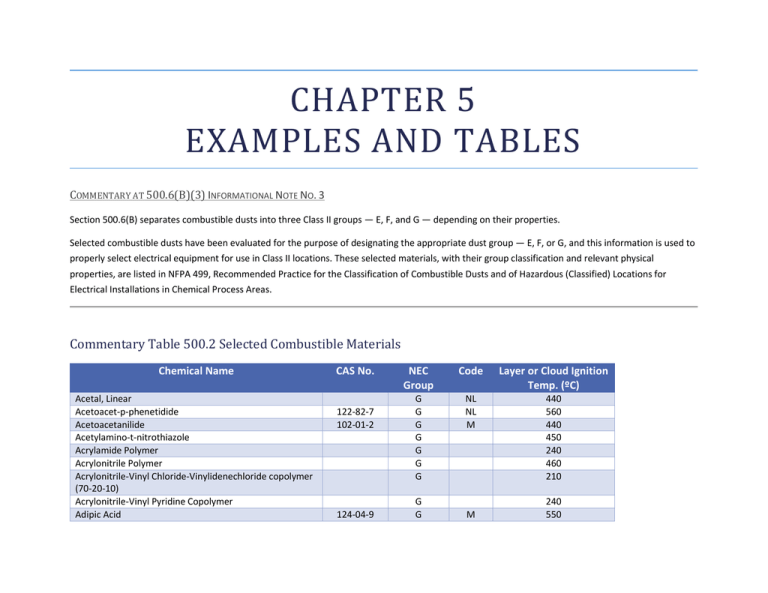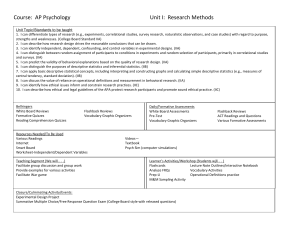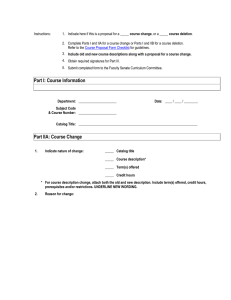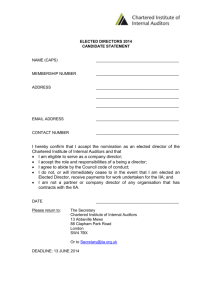chapter 5 examples and tables
advertisement

CHAPTER 5 EXAMPLES AND TABLES COMMENTARY AT 500.6(B)(3) INFORMATIONAL NOTE NO. 3 Section 500.6(B) separates combustible dusts into three Class II groups — E, F, and G — depending on their properties. Selected combustible dusts have been evaluated for the purpose of designating the appropriate dust group — E, F, or G, and this information is used to properly select electrical equipment for use in Class II locations. These selected materials, with their group classification and relevant physical properties, are listed in NFPA 499, Recommended Practice for the Classification of Combustible Dusts and of Hazardous (Classified) Locations for Electrical Installations in Chemical Process Areas. Commentary Table 500.2 Selected Combustible Materials Chemical Name Acetal, Linear Acetoacet-p-phenetidide Acetoacetanilide Acetylamino-t-nitrothiazole Acrylamide Polymer Acrylonitrile Polymer Acrylonitrile-Vinyl Chloride-Vinylidenechloride copolymer (70-20-10) Acrylonitrile-Vinyl Pyridine Copolymer Adipic Acid CAS No. 122-82-7 102-01-2 124-04-9 NEC Group Code Layer or Cloud Ignition Temp. (ºC) G G G G G G G NL NL M 440 560 440 450 240 460 210 G G M 240 550 Alfalfa Meal Alkyl Ketone Dimer Sizing Compound Allyl Alcohol Derivative (CR-39) Almond Shell Aluminum, A422 Flake Aluminum, Atomized Collector Fines Aluminum — cobalt alloy (60-40) Aluminum — copper alloy (50-50) Aluminum — lithium alloy (15% Li) Aluminum — magnesium alloy (Dowmetal) Aluminum — nickel alloy (58-42) Aluminum — silicon alloy (12% Si) Amino-5-nitrothiazole Anthranilic Acid Apricot Pit Aryl-nitrosomethylamide Asphalt Aspirin [acetol (2)] Azelaic Acid Azo-bis-butyronitrile Benzethonium Chloride Benzoic Acid Benzotriazole Beta-naphthalene-axo-dimethylaniline Bis(2-hydroxy-5-chlorophenyl) Methane Bisphenol-A Boron, Commercial Amorphous (85% B) Calcium Silicide Carbon Black (More Than 8% Total Entrapped Volatiles) Carboxymethyl Cellulose Carboxypolymethylene Cashew Oil, Phenolic, Hard Cellulose Cellulose Acetate Cellulose Acetate Butyrate 7429-90-5 121-66-4 118-92-3 8052-42-4 50-78-2 109-31-9 78-67-1 65-85-0 95-14-7 97-23-4 80-05-7 7440-42-8 9000-11-7 G G G G E E E E E E E E G G G G F G G G G G G G G G E E F G G G G G G NL CL CL NL M NL M M CL M M NL M NL NL 200 160 500 200 320 550 570 830 400 430 540 670 460 580 230 490 510 660 610 350 380 440 440 175 570 570 400 540 290 520 180 260 340 370 Cellulose Triacetate Charcoal (Activated) Charcoal (More Than 8% Total Entrapped Volatiles) Cherry Pit Chlorinated Phenol Chlorinated Polyether Alcohol Chloroacetoacetanilide Chromium (97%) Electrolytic, Milled Cinnamon Citrus Peel Coal, Kentucky Bituminous Coal, Pittsburgh Experimental Coal, Wyoming Cocoa Bean Shell Cocoa, Natural, 19% Fat Coconut Shell Coke (More Than 8% Total Entrapped Volatiles) Cork Corn Corn Dextrine Corncob Grit Cornstarch, Commercial Cornstarch, Modified Cottonseed Meal Coumarone-Indene, Hard Crag No. 974 Cube Root, South America Di-alphacumyl Peroxide, 40-60 on CA Diallyl Phthalate Dicyclopentadiene Dioxide Dieldrin (20%) Dihydroacetic Acid Dimethyl Isophthalate Dimethyl Terephthalate 64365-11-3 101-92-8 7440-47-3 533-74-4 83-79-4 80-43-3 131-17-9 60-57-1 1459-93-4 120-61-6 G F F G G G G E G G F F F G G G F G G G G G G G G G G G G G G G G G NL NL M NL CL M NL NL NL M M 430 180 220 570 460 640 400 230 270 180 170 180 370 240 220 210 250 370 240 330 200 200 520 310 230 180 480 420 550 430 580 570 Dinitro-o-toluamide Dinitrobenzoic Acid Diphenyl Ditertiary-butyl-paracresol Dithane m-45 Epoxy Epoxy-bisphenol A Ethyl Cellulose Ethyl Hydroxyethyl Cellulose Ethylene Oxide Polymer Ethylene-maleic Anhydride Copolymer FerbamTM Ferromanganese, Medium Carbon Ferrosilicon (88% Si, 9% Fe) Ferrotitanium (19% Ti, 74.1% Fe, 0.06% C) Flax Shive Fumaric Acid Garlic, Dehydrated Gilsonite Green Base Harmon Dye Guar Seed Gulasonic Acid, Diacetone Gum, Arabic Gum, Karaya Gum, Manila Gum, Tragacanth Hemp Hurd Hexamethylene Tetramine Hydroxyethyl Cellulose Iron, 98% H2 Reduced Iron, 99% Carbonyl Isotoic Anhydride L-sorbose Lignin, Hydrolized, Wood-type, Fine Lignite, California 148-01-6 92-52-4 128-37-0 8018-01-7 14484-64-1 12604-53-4 8049-17-0 110-17-8 12002-43-6 9000-65-1 100-97-0 13463-40-6 G G G G G G G G G G G G E E E G G G F G G G G G G G G G G E E G G G F NL NL M NL NL NL CL NL NL NL CL M NL NL NL CL S NL NL M NL 500 460 630 420 180 540 510 320 390 350 540 150 290 800 380 230 520 360 500 175 500 420 260 240 360 260 220 410 410 290 310 700 370 450 180 Lycopodium Malt Barley Manganese Magnesium, Grade B, Milled Manganese Vancide Mannitol Methacrylic Acid Polymer Methionine (l-methionine) Methyl Cellulose Methyl Methacrylate Polymer Methyl Methacrylate-ethyl Acrylate Methyl Methacrylate-styrene-butadiene Milk, Skimmed N,N-Dimethylthio-formamide Nitropyridone Nitrosamine Nylon Polymer Para-oxy-benzaldehyde Paraphenylene Diamine Paratertiary Butyl Benzoic Acid Pea Flour Peach Pit Shell Peanut Hull Peat, Sphagnum Pecan Nut Shell Pectin Pentaerythritol Petrin Acrylate Monomer Petroleum Coke (More Than 8% Total Entrapped Volatiles) Petroleum Resin Phenol Formaldehyde Phenol Formaldehyde, Polyalkylene-p Phenol Furfural Phenylbetanaphthylamine Phthalic Anydride 7439-96-5 69-65-8 63-68-3 9011-14-7 100703-82-0 63428-84-2 123-08-0 106-50-3 98-73-7 94114-14-4 8002-03-7 5328-37-0 115-77-5 7659-34-9 64742-16-1 9003-35-4 9003-35-4 26338-61-4 135-88-6 85-44-9 G G E E G G G G G G G G G G G G G G G G G G G G G G G G F G G G G G G M NL NL NL M NL CL M M M NL NL NL M 190 250 240 430 120 460 290 360 340 440 440 480 200 230 430 270 430 380 620 560 260 210 210 240 210 200 400 220 500 580 290 310 680 650 Phthalimide Pitch, Coal Tar Pitch, Petroleum Polycarbonate Polyethylene, High Pressure Process Polyethylene, Low Pressure Process Polyethylene Terephthalate Polyethylene Wax Polypropylene (no antioxidant) Polystyrene Latex Polystyrene Molding Compound Polyurethane Foam, Fire Retardant Polyurethane Foam, No Fire Retardant Polyvinyl Acetate Polyvinyl Acetate/Alcohol Polyvinyl Butyral Polyvinyl Chloride-dioctyl Phthalate Potato Starch, Dextrinated Pyrethrum Rayon (Viscose) Flock Red Dye Intermediate Rice Rice Bran Rice Hull Rosin, DK Rubber, Crude, Hard Rubber, Synthetic, Hard (33% S) Safflower Meal Salicylanilide Sevin Shale, Oil Shellac Sodium Resinate Sorbic Acid (Copper Sorbate or Potash) Soy Flour 85-41-6 65996-93-2 68187-58-6 9002-88-4 9002-88-4 25038-59-9 68441-04-8 9003-07-0 9003-53-6 9003-53-6 9009-54-5 9009-54-5 9003-20-7 9002-89-5 63148-65-2 9005-25-8 8003-34-7 61788-77-0 8050-09-7 9006-04-6 64706-29-2 87-17-2 63-25-2 68308-34-9 9000-59-3 61790-51-0 110-44-1 68513-95-1 G F F G G G G G G G G G G G G G G G G G G G G G G G G G G G F G G G G M NL NL NL NL NL NL NL NL NL NL NL NL NL NL NL M NL 630 710 630 710 380 420 500 400 420 500 560 390 440 550 440 390 320 440 210 250 175 220 490 220 390 350 320 210 610 140 400 220 460 190 Soy Protein Stearic Acid, Aluminum Salt Stearic Acid, Zinc Salt Styrene Modified Polyester-Glass Fiber Styrene-acrylonitrile (70-30) Styrene-butadiene Latex (>75% styrene) Styrene-maleic Anhydride Copolymer Sucrose Sugar, Powdered Sulfur Tantalum Terephthalic Acid Thorium (contains 1.2% O) Tin, 96%, Atomized (2% Pb) Titanium, 99% Ti Titanium Hydride (95% Ti, 3.8% H) Trithiobisdimethylthio-formamide Tung, Kernels, Oil-free Urea Formaldehyde Molding Compound Urea Formaldehyde-phenol Formaldehyde Vanadium, 86.4% Vinyl Chloride-acrylonitrile Copolymer Vinyl Toluene-acrylonitrile Butadiene Violet 200 Dye Vitamin B1, Mononitrate Vitamin C Walnut Shell, Black Wheat Wheat Flour Wheat Gluten, Gum Wheat Starch Wheat Straw Wood Flour Woodbark, Ground Yeast, Torula 9010-10-0 637-12-7 557-05-1 100-42-5 9003-54-7 903-55-8 9011-13-6 57-50-1 57-50-1 7704-34-9 7440-25-7 100-21-0 7440-29-1 7440-31-5 7440-32-6 7704-98-5 8001-20-5 9011-05-6 25104-55-6 7440-62-2 9003-00-3 76404-69-8 59-43-8 50-81-7 130498-22-5 100684-25-1 68602-94-8 G G G G G G G G G G E G E E E E G G G G E G G G G G G G G G G G G G G M NL NL CL CL CL NL CL CL CL NL NL NL NL NL 260 300 510 360 500 440 470 350 370 220 300 680 270 430 330 480 230 240 460 240 490 470 530 175 360 280 220 220 360 520 380 220 260 250 260 Zirconium Hydride Zirconium (contains 0.3% O) 7704-99-6 7440-67-7 E E CL 270 330 Notes: 1. Normally, the minimum ignition temperature of a layer of a specific dust is lower than the minimum ignition temperature of a cloud of that dust. Since this is not universally true, the lower of the two minimum ignition temperatures is listed. If no symbol appears in the “Code” column, then the layer ignition temperature is shown. “CL” means the cloud ignition temperature is shown. “NL” means that no layer ignition temperature is available, and the cloud ignition temperature is shown. “M” signifies that the dust layer melts before it ignites; the cloud ignition temperature is shown. “S” signifies that the dust layer sublimes before it ignites; the cloud ignition temperature is shown. 2. Certain metal dusts may have characteristics that require safeguards beyond those required for atmospheres containing the dusts of aluminum, magnesium, and their commercial alloys. For example, zirconium and thorium dusts may ignite spontaneously in air, especially at elevated temperatures. 3. Due to the impurities found in coal, its ignition temperatures vary regionally and ignition temperatures are not available for all regions in which coal is mined. Source: NFPA 499-2008, Recommended Practice for the Classification of Combustible Dusts and of Hazardous (Classified) Locations for Electrical Installations in Chemical Process Areas, Table 4.5.2. COMMENTARY AT 500.6(A)(4) INFORMATIONAL NOTE NO. 2 Flammable gases, flammable liquid–produced vapors, and combustible liquid–produced vapors are separated into four Class I groups — A, B, C, and D (or three Class I zone groups — IIC, IIB, and IIA; see 505.6) depending on their properties. By grouping explosive mixtures that have similar igniting current ratios and maximum safe clearances between parts of a joint in an enclosure, equipment can be designed for the entire group rather than an individual chemical. The Code requirements for Class I locations do not vary for different kinds of gas or vapor contained in a group, except as in Exceptions No. 1 and No. 2 to 500.6(A)(2). This method makes it easier to properly select equipment designed for use in the particular group involved. Selected combustible materials have been evaluated for the purpose of designating the appropriate gas group — A, B, C, or D (or IIC, IIB, or IIA), and this information is used to properly select electrical equipment for use in Class I locations. These materials, with their group classification and relevant physical properties, are listed in NFPA 497, Recommended Practice for the Classification of Flammable Liquids, Gases, or Vapors and of Hazardous (Classified) Locations for Electrical Installations in Chemical Process Areas. Many documents used to determine an area’s classification do not require a hazardous classification unless the location contains a concentration over 25 percent of the material’s lower flammable limit (LFL). Commentary Table 500.1 Selected Chemicals Chemical Acetaldehyde Acetic Acid Acetic Acid-tert-Butyl Ester Acetic Anhydride Acetone Acetone Cyanohydrin Acetonitrile Acetylene Acrolein (Inhibited) Acrylic Acid Acrylonitrile Adiponitrile Allyl Alcohol Allyl Chloride Allyl Glycidyl Ether Alpha-Methyl Styrene n-Amyl Acetate sec-Amyl Acetate Ammonia Aniline Benzene CAS No. 75-07-0 64-19-7 540-885 108-247 67-64-1 75-86-5 75-05-8 74-86-2 107-028 79-10-7 107-131 111-693 107-186 107-051 106-923 98-83-9 628-637 626-380 766441-7 62-53-3 71-43-2 Class I Division Group Cd Dd D Typea D II 49 Dd D D Ad B(C)d I IIIA I GAS I –20 74 6 D Dd II I D Vapor Pressureb (mm Hg) 874.9 15.6 40.6 Class I Zone Groupc IIA IIA 1.7 60.0 19.9 9.8 Vapor Density (Air = 1) 1.5 2.1 4.0 316 2.7 10.3 3.5 4.9 IIA 465 688 524 305 235 2.5 2.2 3.0 2.5 2.8 12.8 12.0 16.0 100 31.0 2.0 2.9 1.4 0.9 1.9 230.7 0.3 91.1 36600 274.1 IIA 54 0 438 481 2.4 3 8.0 17 2.5 1.8 4.3 108.5 IIB IIB IIIA 93 550 1.0 0.002 Cd I 22 378 2.5 18.0 2.0 25.4 IIB D I –32 485 2.9 11.1 2.6 366 IIA B(C)e II 57 D D II I 25 574 360 2.7 4.2 IIA D I 23 Dd,f GAS D Dd IIIA I I II II Flash Point (ºC) –38 39 70 –11 AIT (ºC) %LFL %UFL 175 426 4.0 IIA IIC IIB MIE (mJ) MIC Ratio MESG (mm) 0.37 0.98 2.67 0.92 1.76 1.23 1.15 0.017 0.13 0.16 1.00 1.02 0.28 1.50 0.25 0.78 0.86 0.87 0.84 1.33 1.17 3.9 0.8 1.1 11.0 7.5 4.1 4.5 1.1 7.5 4.5 651 15 28 0.6 7498.0 IIA 680 6.85 3.17 615 498 1.2 1.2 8.3 7.8 3.2 2.8 0.7 94.8 IIA IIA 0.20 1.00 0.99 1.02 IIA Benzyl Chloride Bromopropyne n-Butane 1,3-Butadiene 1-Butanol Butyl alcohol (s) (butanol2) Butylamine Butylene n-Butyraldehyde n-Butyl Acetate sec-Butyl Acetate tert-Butyl Acetate n-Butyl Acrylate (Inhibited) n-Butyl Glycidyl Ether n-Butyl Formal Butyl Mercaptan Butyl-2-Propenoate para tert-Butyl Toluene n-Butyric Acid 98-87-3 106-967 358347-9 106-990 71-36-3 78-92-2 109-739 2516767-3 123-728 123-864 105-464 540-885 141-322 242608-6 110-623 109-795 141-322 98-51-1 107-926 D D IIIA I 585 324 1.1 3.0 Dd,g GAS 288 1.9 8.5 2.0 IIA 0.25 0.94 1.07 B(D)d,e GAS 420 2.0 11.5 1.9 IIB 0.13 0.76 0.79 Dd Dd I I 36 23.8 343 405 1.4 1.7 11.2 9.8 2.6 2.6 7.0 IIA IIA D GAS –12 312 1.7 9.8 2.5 92.9 IIA D I 385 1.6 10.0 1.9 2214.6 IIA 0.94 Cd I –12 218 1.9 12.5 2.5 112.2 IIA 0.92 Dd I –2 421 1.7 7.6 4.0 11.5 IIA D II 28 1.7 9.8 4.0 22.2 D II 1.7 9.8 4.0 40.6 D II 1.7 9.9 4.4 5.5 B(C)e II C IIIA C I 2 D II 49 D Dd IIIA IIIA 72 10 49 293 4.4 0.5 34.3 443 3.1 46.4 1.7 9.9 4.4 5.5 2.0 10.0 3.0 0.8 IIB 0.91 1.13 1.08 1.04 0.88 Carbon Disulfide Carbon Monoxide Chloroacetaldehyde Chlorobenzene 1-Chloro-1-Nitropropane Chloroprene Cresol Crotonaldehyde Cumene Cyclohexane Cyclohexanol Cyclohexanone Cyclohexene Cyclopropane p-Cymene Decene n-Decaldehyde n-Decanol Decyl Alcohol 75-15-0 630-080 107-200 108-907 242566-3 126-998 131977-3 417030-3 98-82-8 110-827 108-930 108-941 110-838 75-19-4 99-87-6 872-059 112-312 112-301 112-301 d,h Cd I GAS –30 90 609 1.3 12.5 50.0 74 2.6 0.97 358.8 IIC IIB 0.009 0.39 0.20 0.54 C IIIA 88 D I 29 C IIIA D GAS –20 D IIIA 81 559 1.1 Cd I 13 232 2.1 15.5 2.4 33.1 IIB 0.81 D D I I 36 –17 424 245 0.9 1.3 6.5 8.0 4.1 2.9 4.6 98.8 IIA IIA 1.05 0.94 D IIIA 68 300 3.5 0.7 IIA D II 44 420 1.1 3.4 4.3 IIA D I –6 244 1.2 2.8 89.4 IIA Dd D D I II II 47 503 436 235 2.4 0.7 1.5 4.6 4.8 5430 1.5 1.7 IIA IIA C IIIA D IIIA 82 288 5.3 0.008 D IIIA 82 288 5.3 0.008 63.1 593 1.3 9.6 3.9 4.0 20.0 3.0 11.9 3.7 9.4 10.4 5.6 0.09 0.22 1.0 0.98 0.97 0.17 0.84 0.91 Diacetone Alcohol Di-Isobutylene Di-Isobutyl Ketone o-Dichlorobenzene 1,4-Dichloro-2,3 Epoxybutane 1,1-Dichloroethane 1,2-Dichloroethylene 1,1-Dichloro-1Nitroethane 1,3-Dichloropropene Dicyclopentadiene Diethylamine Diethylaminoethanol Diethyl Benzene Diethyl Ether (Ethyl Ether) Diethylene Glycol Monobutyl Ether Diethylene Glycol Monomethyl Ether n-n-Dimethyl Aniline Dimethyl Formamide Dimethyl Sulfate 123-422 2516770-8 108-838 955-501 358347-9 130021-6 156-592 594-729 1006102-6 77-73-6 109-879 100-378 2534017-4 60-29-7 112-345 111-773 121-697 68-12-2 77-78-1 D IIIA 64 603 1.8 6.9 4.0 1.4 Dd I 2 391 0.8 4.8 3.8 D II 60 396 0.8 7.1 4.9 D IIIA 66 647 2.2 9.2 5.1 IIA Dd I 1.9 8.5 2.0 IIA D I 438 6.2 16.0 3.4 227 IIA 1.82 D I 97 460 5.6 12.8 3.4 204 IIA 3.91 C IIIA 76 D I 35 C Cd I I 32 –28 503 312 2.8 IIA IIA 0.91 1.15 C IIIA 60 320 4.0 1.6 IIA D II 57 395 4.6 Cd C I IIIA –45 78 160 228 538 0.02 IIB C IIIA 93 241 C IIIA 63 371 1.0 D D II IIIA 58 83 455 188 2.2 0.96 1.7 0.25 0.98 1.07 5.0 5.3 14.5 3.8 1.8 10.1 2.5 1.9 0.9 36 24.6 2.6 5.6 0.19 0.88 0.83 0.2 15.2 4.2 0.7 2.5 4.4 4.1 0.7 IIA 1.08 Dimethylamine 2,2-Dimethylbutane 2,3-Dimethylbutane 3,3-Dimethylheptane 2,3-Dimethylhexane 2,3-Dimethylpentane Di-N-Propylamine 1,4-Dioxane Dipentene Dipropylene Glycol Methyl Ether Diisopropylamine Dodecene Epichlorohydrin Ethane Ethanol Ethylamine Ethylene Ethylenediamine Ethylenimine Ethylene Chlorohydrin 124-403 75-83-2 78-29-8 107126-7 3139454-4 107-835 142-847 123-911 138-863 3459094-8 108-189 684215-5 313264-7 74-84-0 64-17-5 75-04-7 74-85-1 107-153 151-564 107-073 C GAS 400 Dg Dg Dg I I I Dg I 438 Dg I 335 211.7 C I 17 299 27.1 IIA Cd I 12 180 2.0 22.0 3.0 38.2 IIB D II 45 237 0.7 6.1 4.7 C IIIA 85 1.1 3.0 5.1 C GAS –6 316 1.1 7.1 3.5 D IIIA 100 255 Cd I 33 411 3.8 21.0 3.2 Dd Dd Dd Cd Dd GAS I I GAS I –29 13 –18 33 472 363 385 490 385 3.0 3.3 3.5 2.7 2.5 12.5 19.0 14.0 36.0 12.0 1.0 1.6 1.6 1.0 2.1 Cd I –11 320 3.3 54.8 1.5 211 D IIIA 59 425 4.9 15.9 2.8 7.2 –48 2.8 14.4 1.6 405 396 325 IIA 319.3 10.8 0.95 0.19 0.70 IIA 1.18 IIA 1.02 0.5 13.0 59.5 1048 IIA IIA IIB 0.24 2.4 0.070 12.5 0.48 0.82 0.88 0.91 0.89 0.53 0.65 Ethylene Dichloride Ethylene Glycol Monoethyl Ether Acetate Ethylene Glycol Monobutyl Ether Acetate Ethylene Glycol Monobutyl Ether Ethylene Glycol Monoethyl Ether Ethylene Glycol Monomethyl Ether Ethylene Oxide 2-Ethylhexaldehyde 2-Ethylhexanol 2-Ethylhexyl Acrylate Ethyl Acetate Ethyl Acrylate (Inhibited) Ethyl Alcohol Ethyl Sec-Amyl Ketone Ethyl Benzene Ethyl Butanol Ethyl Butyl Ketone Ethyl Chloride Ethyl Formate Ethyl Mercaptan 107-062 111-159 112-072 111-762 110-805 109-864 75-21-8 123-057 104-767 103-093 141-786 140-885 64-17-5 541-855 100-414 97-95-0 106-354 75-00-3 109-944 75-08-1 Dd I 13 413 6.2 16.0 3.4 79.7 C II 47 379 1.7 4.7 2.3 C IIIA 340 0.9 8.5 C IIIA 238 1.1 12.7 4.1 1.0 C II 235 1.7 15.6 3.0 5.4 0.84 D II 285 1.8 14.0 2.6 9.2 0.85 B(C)d,e C I II –20 52 429 191 3 0.8 100 7.2 1.5 4.4 1314 1.9 D IIIA 81 0.9 9.7 4.5 0.2 D IIIA 88 252 Dd I –4 427 2.0 11.5 3.0 Dd I 9 372 1.4 14.0 Dd D I II 13 59 363 3.3 D I 15 432 D D II II 57 46 D D GAS GAS –50 –20 Cd I –18 IIA 0.53 0.97 0.9 IIB 0.065 93.2 IIA 0.46 3.5 37.5 IIA 19.0 1.6 59.5 IIA 0.8 6.7 3.7 9.6 1.2 7.7 3.5 4.0 1.5 3.6 519 455 3.8 2.8 15.4 16.0 2.2 2.6 300 2.8 18.0 2.1 0.47 0.59 0.3 0.99 0.86 0.88 IIA 527.4 IIB 0.89 0.94 0.90 0.90 n-Ethyl Morpholine 2-Ethyl-3-Propyl Acrolein Ethyl Silicate Formaldehyde (Gas) Formic Acid Fuel Oil 1 100-743 645-625 78-10-4 50-00-0 64-18-6 800820-6 C I 32 4.0 C IIIA 68 4.4 D B D D C C Dd II GAS II II or IIIAk II or IIIAk IIIA or IIIBk IIIA IIIA I 50 38– 72k 52– 96k 66– 132k 60 75 –46 Dd I Dg 73 57.0 5.0 316 490 280 2.1 1.8 1.4 19.3 16.3 7.6 3.3 3.4 3.0 2.3 0.6 –4 204 1.0 6.7 3.5 45.5 I –1 204 Dd,g I –23 225 D IIIA 63 D I 35 424 1.2 8.0 D I –26 245 1.2 6.9 D II 45 C II 38 Bd GAS Fuel Oil 6 Furfural Furfuryl Alcohol Gasoline n-Heptane n-Heptene n-Hexane Hexanol 2-Hexanone Hexene sec-Hexyl Acetate Hydrazine Hydrogen 98-01-1 98-00-0 800661-9 142-825 8162404-6 110-543 111-273 591-786 592-416 108-849 302-012 133374-0 7.2 1.0 1.6 7 18.0 0.7 Fuel Oil 2 430 434 210 42.7 IIB IIA 0.57 1.86 257 0.94 IIA 0.24 0.88 3.4 1.1 7.5 0.91 0.97 3.0 152 IIA 3.5 0.8 IIA 3.5 10.6 0.24 0.88 0.93 0.98 186 5.0 23 500 4 98.0 1.1 75 0.1 14.4 IIC 0.019 0.25 0.28 Hydrogen Cyanide Hydrogen Selenide Hydrogen Sulfide Isoamyl Acetate Isoamyl Alcohol Isobutane Isobutyl Acetate Isobutyl Acrylate Isobutyl Alcohol Isobutyraldehyde Isodecaldehyde Isohexane Isopentane Isooctyl Aldehyde Isophorone Isoprene Isopropyl Acetate Isopropyl Ether Isopropyl Glycidyl Ether Isopropylamine Kerosene 74-90-8 778307-5 778306-4 123-922 123-513 75-28-5 110-190 106-638 78-83-1 78-84-2 112-312 107-835 78-78-4 123-057 78-59-1 78-79-5 108-214 108-203 401614-2 75-31-0 800820-6 Cd C GAS I Cd GAS D I D –18 538 5.6 40.0 0.9 IIB 260 4.0 44.0 1.2 25 360 1.0 7.5 4.5 6.1 II 43 350 1.2 9.0 3.0 3.2 Dg Dd GAS I 18 460 421 1.8 2.4 8.4 10.5 2.0 4.0 17.8 D I 4.4 7.1 Dd C C I GAS IIIA 2.5 2.5 5.4 10.5 427 –40 –40 Dg Dg C II D Dd D I I Dd I C I D D GAS II 0.80 7793 416 196 1.2 1.6 10.9 10.6 IIB 0.068 0.90 IIA 1.02 IIA 0.95 IIA IIA 0.92 IIA 1.00 0.98 0.92 0.09 264 211.7 420 197 688.6 1.9 84 –54 460 220 460 0.8 1.5 1.8 3.8 8.9 8.0 4.8 2.4 3.5 0.4 550.6 60.4 –28 443 1.4 7.9 3.5 148.7 –26 72 402 210 2.3 0.7 10.4 5.0 2.0 IIA 1.14 2.0 IIA 0.94 Liquefied Petroleum Gas Mesityl Oxide Methane Methanol Methyl Acetate Methyl Acrylate Methyl Alcohol Methyl Amyl Alcohol Methyl Chloride Methyl Ether Methyl Ethyl Ketone Methyl Formal Methyl Formate 2-Methylhexane Methyl Isobutyl Ketone Methyl Isocyanate Methyl Mercaptan Methyl Methacrylate Methyl N-Amyl Ketone Methyl Tertiary Butyl Ether 2-Methyloctane 2-Methylpropane Methyl-1-Propanol 6847685-7 141-979 74-82-8 67-56-1 79-20-9 96-33-3 67-56-1 108-112 74-87-3 115-106 78-93-3 534-156 107-313 3139454-4 141-797 624-839 74-93-1 80-62-6 110-430 163404-4 322161-2 75-28-5 78-83-1 D I Dd I Dd Dd D D Dd D GAS I GAS GAS I II D Cd GAS GAS Dd Cd 405 31 344 1.4 7.2 3.4 12 –10 23 600 385 454 468 385 5 6.0 3.1 2.8 6.0 1.0 15 36.0 16.0 25.0 36 5.5 0.6 1.1 2.6 3.0 1.1 3.5 –46 –41 632 350 8.1 3.4 17.4 27.0 1.7 1.6 I I –6 1 404 238 1.4 11.4 2.5 3.1 D GAS –19 449 4.5 23.0 2.1 Dg I Dd I 31 440 1.2 8.0 3.5 D GAS –15 534 5.3 26.0 2.0 C D D GAS I II –18 10 49 422 393 3.9 1.7 1.1 21.8 8.2 7.9 1.7 3.6 3.9 37.2 3.8 D I –80 435 1.6 8.4 0.2 250.1 Dg Dd I I 41 47.6 126.3 126.3 5.3 IIA IIA IIA IIB IIA IIA 0.28 0.14 IIA IIB 92.4 IIB 0.53 1.00 0.82 1.08 0.98 1.12 0.92 0.99 0.85 0.91 1.01 0.85 1.00 0.84 0.92 0.84 IIA 0.94 IIA 1.21 IIA 0.95 IIA 0.98 280 –40 11 220 6.3 460 416 2639 10.1 1.2 10.9 2.5 Methyl-2-Propanol 2-Methyl-5-Ethyl Pyridine Methylacetylene MethylacetylenePropadiene Methylal Methylamine 2-Methylbutane Methylcyclohexane Methylcyclohexanol 2-Methycyclohexanone 2-Methylheptane 3-Methylhexane 3-Methylpentane 2-Methylpropane 2-Methyl-1-Propanol 2-Methyl-2-Propanol 2-Methyloctane 3-Methyloctane 4-Methyloctane Monoethanolamine Monoisopropanolamine Monomethyl Aniline Monomethyl Hydrazine 75-65-0 104-905 74-99-7 2784630-6 109-875 74-89-5 78-78-4 208-872 2563042-3 583-608 589-344 94-14-0 75-28-5 78-83-1 75-65-0 221632-2 221633-3 221634-4 141-435 78-96-6 100-618 60-34-4 Dd D I Cd C I I C I D Dg D GAS I D D 10 74 360 2.4 1.1 8.0 6.6 1.7 42.2 1.4 4306 –18 237 1.6 17.6 2.6 –56 –4 430 420 250 4.9 1.4 1.2 20.7 8.3 6.7 1.0 2.6 3.4 68 296 420 280 Dg Dg Dd Dd Dg 278 460 223 478 220 IIA 1.10 398 688.6 0.27 –40 61.5 1.2 2.4 10.9 8.0 2.5 2.6 2639 10.5 42.2 Dg 220 6.3 Dg 225 6.8 D 85 410 2.1 0.4 D C 77 374 482 2.6 1.1 0.5 23 194 I 0.74 3.9 Dg Dg C 0.11 IIB 3.9 II I I I 2.6 4.2 2.5 92.0 1.6 IIA Morpholine Naphtha (Coal Tar) Naphtha (Petroleum) Neopentane Nitrobenzene Nitroethane Nitromethane 1-Nitropropane 2-Nitropropane n-Nonane Nonene Nonyl Alcohol n-Octane Octene n-Octyl Alcohol n-Pentane 1-Pentanol 2-Pentanone 1-Pentene 2-Pentene 110-918 803030-6 803030-6 463-821 98-95-3 79-24-3 75-52-5 108-032 79-46-9 111-842 2721495-8 143-088 111-659 2537783-7 111-875 109-660 71-41-0 107-879 109-671 109-682 Cd II 35 310 1.4 11.2 D II 42 277 Dd,i I 42 288 1.1 5.9 2.5 Dg –65 450 1.4 8.3 2.6 1286 D C C C I I I 88 28 35 34 482 414 418 421 1.8 3.4 7.3 2.2 4.3 2.6 2.1 3.1 0.3 20.7 36.1 10.1 IIA IIB IIA IIB Cd Dg I I 28 31 428 205 2.6 0.8 3.1 4.4 17.1 4.4 IIA D I 10.1 IIA 0.95 IIA 11.0 2.9 0.8 D 3.0 IIA 0.92 0.94 0.87 1.17 0.84 4.4 0.8 6.1 5.0 0.02 IIA 6.5 3.9 14.0 IIA 0.94 4.5 0.08 IIA 1.05 Dd,g I 13 206 1.0 D I 8 230 0.9 3.9 D Dd,g I –40 243 1.5 7.8 2.5 513 IIA Dd D I I 33 7 300 452 1.2 1.5 10.0 8.2 3.0 3.0 2.5 35.6 IIA IIA D I –18 275 1.5 8.7 2.4 639.7 D I –18 2.4 0.28 0.97 0.93 1.30 0.99 2-Pentyl Acetate Phenylhydrazine Process Gas > 30% H2 Propane 1-Propanol 2-Propanol Propiolactone Propionaldehyde Propionic Acid Propionic Anhydride n-Propyl Acetate n-Propyl Ether Propyl Nitrate Propylene Propylene Dichloride Propylene Oxide Pyridine Styrene Tetrahydrofuran Tetrahydronaphthalene Tetramethyl Lead 626-380 100-630 133374-0 74-98-6 71-23-8 67-63-0 57-57-8 123-386 79-09-4 123-626 109-604 111-433 627-134 115-071 78-87-5 75-56-9 110-861 100-425 109-999 119-642 75-74-1 D I D 23 1.1 7.5 89 Bj GAS Dd Dd Dd D C GAS I I 4.5 3.7 0.03 520 4.0 75.0 0.1 15 12 450 413 399 9.5 13.7 12.7 I –9 207 2.1 2.2 2.0 2.9 2.6 17.0 1.6 2.1 2.1 2.5 2.0 20.7 45.4 2.2 318.5 D D II 54 74 466 285 2.9 1.3 12.1 9.5 2.5 4.5 D I 14 450 1.7 8.0 Cd I 21 215 1.3 7.0 Bd I 20 175 2.0 100.0 Dd GAS 460 2.4 10.3 1.5 D B(C)d,e Dd I I I 16 –37 20 557 449 482 3.4 2.3 1.8 14.5 36.0 12.4 3.9 2.0 2.7 Dd I 31 490 0.9 6.8 Cd I –14 321 2.0 D IIIA 385 0.8 C II 38 IIA IIA IIA 0.019 0.45 0.25 0.82 0.65 0.97 0.89 1.00 IIB 0.86 3.7 1.4 IIA 1.10 3.5 33.4 IIA 1.05 3.5 62.3 IIA 0.28 0.91 51.7 534.4 20.8 IIA IIB IIA 0.13 1.32 0.70 3.6 6.1 IIA 11.8 2.5 161.6 IIB 5.0 4.6 0.4 9.2 1.21 0.54 0.87 Toluene n-Tridecene Triethylamine Triethylbenzene 2,2,3-Trimethylbutane 2,2,4-Trimethylbutane 2,2,3-Trimethylpentane 2,2,4-Trimethylpentane 2,3,3-Trimethylpentane Tripropylamine Turpentine n-Undecene Unsymmetrical Dimethyl Hydrazine Valeraldehyde Vinyl Acetate Vinyl Chloride Vinyl Toluene Vinylidene Chloride Xylene Xylidine 108-883 243756-1 121-448 2534018-5 102-692 800664-2 2876127-5 57-14-7 110-623 108-054 75-01-4 2501315-4 75-35-4 133020-7 121-697 Dd I D IIIA Cd I D 4 480 1.1 7.1 3.1 28.53 6.4 593.4 8.0 3.5 68.5 56.0 5.6 0.6 –9 249 1.2 83 Dg Dg Dg Dg Dg D 442 407 396 415 425 II 41 D I 35 D IIIA Cd I –15 249 C I 280 222 Dd I –6 402 2.6 Dd D GAS –78 52 472 494 D Dd I I 25 C IIIA 63 4.9 253 0.8 0.24 IIA 0.75 1.05 IIA 1.04 IIA 1.13 4.8 0.7 2.0 1.5 IIA 5.5 95.0 1.9 IIB 3.0 34.3 13.4 3.0 113.4 3.6 0.8 33.0 11.0 2.2 4.1 570 464 6.5 0.9 15.5 7.0 3.4 3.7 599.4 371 1.0 4.2 0.7 IIA 0.70 IIA a Type is used to designate if the material is a gas, flammable liquid, or combustible liquid. (See 4.2.6 and 4.2.7 of NFPA 497.) b Vapor pressure reflected in units of mm Hg at 25ºC (77ºF) unless stated otherwise. IIA IIA 0.94 0.96 0.2 3.91 1.09 c Class I, Zone Groups are based on 1996 IEC TR3 60079-20, Electrical apparatus for explosive gas atmospheres — Part 20: Data for flammable gases and vapors, relating to the use of electrical apparatus, which contains additional data on MESG and group classifications. d Material has been classified by test. e Where all conduit runs into explosionproof equipment are provided with explosionproof seals installed within 450 mm (18 in.) of the enclosure, equipment for the group classification shown in parentheses is permitted. f For classification of areas involving ammonia, see ASHRAE 15, Safety Code for Mechanical Refrigeration, and ANSI/CGA G2.1, Safety Requirements for the Storage and Handling of Anhydrous Ammonia. g Commercial grades of aliphatic hydrocarbon solvents are mixtures of several isomers of the same chemical formula (or molecular weight). The autoignition temperatures of the individual isomers are significantly different. The electrical equipment should be suitable for the AIT of the solvent mixture. (See A.4.4.2 of NFPA 497.) h Certain chemicals have characteristics that require safeguards beyond those required for any of the above groups. Carbon disulfide is one of these chemicals because of its low autoignition temperature and the small joint clearance necessary to arrest its flame propagation. I Petroleum naphtha is a saturated hydrocarbon mixture whose boiling range is 20ºC to 135ºC (68ºF to 275ºF). It is also known as benzine, ligroin, petroleum ether, and naphtha. j Fuel and process gas mixtures found by test not to present hazards similar to those of hydrogen may be grouped based on the test results. k Liquid type and flash point vary due to regional blending differences. Source: NFPA 497-2008, Recommended Practice for the Classification of Flammable Liquids, Gases, or Vapors and of Hazardous (Classified) Locations for Electrical Installations in Chemical Process Areas, Table 4.4.2



